Chapter 1 - Telescopes and Mountings
Jack Kramer
1. The Different Types of Telescopes
Refractor
A refractor is the type that has an objective lens at one end and an eyepiece
at the other. It's the type of telescope that Galileo used and is what most
people think of when the word "telescope" is heard. In essence, binoculars are
simply two short-focus, wide-field telescopes placed together so that you can
use both eyes simultaneously. Refractors are the type normally sold in
department stores, but these are generally of poor quality. A good
refractor is expensive, but it presents a superb image.

Newtonian Reflector
The simple Newtonian reflector (which was not invented by Isaac Newton, but by James Gregory in 1663) has a concave mirror at the lower end. This mirror magnifies the image and focuses the light rays to a smaller mirror (the "diagonal" or "secondary") at the top of the tube, where the eyepiece is positioned. The eyepiece further magnifies the image.
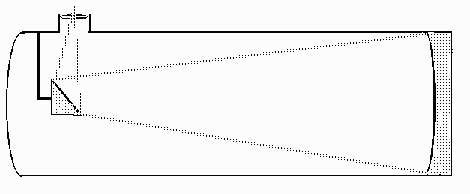
Schmidt-Cassegrain
Since the early 70's, the Schmidt-Cassegrain telescope (SCT) design has
been increasing in popularity. Today it's one of the most widely-used types.
It's often referred-to as a "folded" design, with a mirror at the back and a
corrector plate at the front; a secondary mirror mounted on the corrector
directs the light rays back through a hole in the primary mirror. The corrector
plate is really a very thin lens that modifies ("corrects") the incoming light
rays before they reach the primary mirror. As you can see, this telescope
design employs the principle of the concave mirror as in the Newtonian, along
with more exotic lens configurations. Probably the single biggest thing going
for the SCT is its compactness, which makes it the most portable of all the
common designs. Moreover, this feature makes it easy to attach accessories and
motorize the mounting to follow the motions of stars and planets. Of course,
this all comes at a price; even the simplest SCT is more expensive than a
comparable Newtonian. However, the popularity of the SCT and the benefits of
mass production are narrowing this price gap and making the SCT an extremely
attractive instrument for many astronomers. Also, the SCT is much less
expensive than a comparable refractor. Herein lies one of the problems. Many
people who are new to astronomy are enchanted by the features of the SCT; they
go whole hog and spend $1000 to $2000 on one of these scopes. When they take it
home, they discover that they don't know enough about astronomy to utilize this
instrument in the way it was intended. In short order, they become frustrated.
If you read the astronomy magazines, you'll often see want ads for used SCTs
with comments like "seldom used" and "used twice"; I've even seen a couple that
said "never used"!
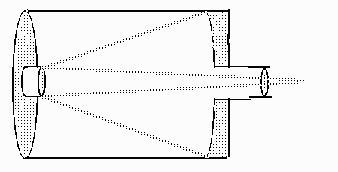
Comparing the Different Designs
An objective lens for a refractor will always be much more expensive than a mirror in a reflecting telescope for a number of reasons:
- An objective lens is not a single lens, but two or more individual lenses that are mounted together to make the image achromatic; that is, so all the various light waves come together at the same point without producing a little rainbow (color fringe) around bright objects.
- These individual lenses are ground and polished on both surfaces, so much more work is involved in manufacturing a good refracting objective. A mirror is ground on only one side so the effort (and cost) is much less.
- Because light has to pass through the lens, the quality of the optical glass must be of the highest order. Achromatic objectives generally require two different types of optical glass - "crown" and "flint". Some use a fluorite element, as well, and the very latest versions use "ED", low dispersion glass.
With these considerations in mind, it becomes pretty obvious why the inexpensive refractors sold in department stores are of such poor quality. You do get what you pay for!
Even though many people grind their own mirrors, good commercially-made mirrors, and complete reflecting telescopes, are relatively inexpensive. Due to the cost advantage, reflecting-type telescopes (and Newtonians, in particular) tend to be larger in diameter than refractors. As the diameter of the optics increase, so does the ability of the telescope to gather more light. A general rule is that the more light gathered, the more you'll see. So there are some big advantages to the reflector, not the least of which is cost. There is one trade-off, however; a good refractor tends to give a somewhat sharper image than most reflectors because they lack the central obstruction of a secondary mirror. Because of this, some astronomers who concentrate on observing the planets (which require especially crisp images) will opt to use a refractor. Also, if most observing will be done from areas with considerable light pollution, then a refractor makes good sense because in addition to gathering more light, larger reflectors also gather more light pollution. This often makes large optics self-defeating when used in a metropolitan environment.
Getting Started
So what's the best way for the newcomer to begin? First of all, learn your way around the sky with just your eyes, then with a binocular or small spotting scope. When you feel comfortable in space, then consider moving up to a larger instrument. Some people advise that you first get to the point where you've exhausted the capabilities of your present optical instrument, and only then should you move up. The truth is that you'll never exhaust the capabilities because there's always something in the sky that is within the range of your instrument. Perhaps the best advice is to decide where your main interests lie and the level at which you want to pursue these. By all means, talk to other experienced amateur astronomers to get a feel for some of the different avenues you might pursue.
A never-ending debate continues about which telescope design is best. The real answer is that there simply isn't any single "best" design. Each type has its advantages and drawbacks; what's ideal for you depends on you yourself. Taking into consideration the factors of cost and light grasp, a small Newtonian reflector is probably the best all-purpose choice for the beginner who already knows his or her way around the sky and is capable of maintaining a telescope. It's a simple optical system and is the scope that amateur astronomers have been building for generations. (A "small" Newtonian means one with an objective mirror of 3" to 6" in diameter.)
As noted before, expect to spend a minimum of $250 to $300 for a new telescope (with mounting). It's best to patronize a shop that specializes in optical equipment, rather than a department store. You may also want to check the ads in astronomy magazines, which aim their wares toward knowledgeable amateur astronomers who can quickly spot anything that's garbage. If you check the pages of Astronomy and Sky & Telescope magazines, you won't see the telescopes sold in department stores advertised there. Merchants who advertize in the astronomy press know they have to provide good instruments and good service, otherwise they won't stay in business. One alternative is to talk to members of an astronomy club, who often have the inside track on some good used telescopes that might be for sale; here's where you'll get a real bargain. And if you eventually decide to make your own telescope, an astronomy club can be very helpful.
2. Telescope Mountings
The mounting is simply the apparatus that holds your telescope and allows you to move it about to locate the various objects in the sky. In many respects, the quality and design of the mounting is as important as the telescope itself, since a poor mounting will not hold the telescope steadily enough for you to see anything. The best telescope on a poor mounting is all but useless! There are two general types of mountings: equatorial and altazimuth.
Altazimuth
The simplest type is the altazimuth. It moves up-and-down (altitude) and left-and-right (azimuth). A small telescope set up on a camera tripod is, in effect, on an altazimuth mounting. A sturdy camera tripod may be perfectly adequate for a spotting scope. Many small commercial refracting telescopes are sold with altazimuth mounts. When you have an object in your field of view, it will move out of the field due to the rotation of the Earth. To reposition your telescope on the object, you have to move the telescope to the right and slightly up or down. Many altazimuth mounts come with slow-motion controls and cables for hand operation. This allows you to more easily follow objects in the sky by use of the manual slow-motion feature. A big limitation of this type of mounting, however, is that it is very awkward to use when objects are high overhead near the zenith. In fact, many altazimuth mountings are limited by designs that prevent you from pointing the telescope directly up toward the zenith. In effect, there's a "blind spot" overhead; to observe an object in this part of the sky, you'd just have to wait until the normal diurnal motion of the sky carries it to a point where it's no longer directly overhead.
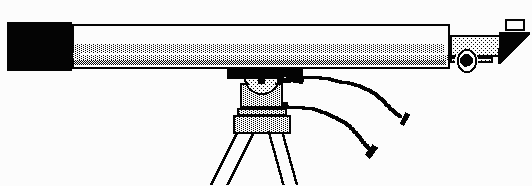
Dobsonian
The Dobsonian mountings used on many large telescopes are just another version of the altazimuth. Their main advantages are low cost, ease of construction, light weight, and good stability. The limitation is that they can't be used for astrophotography, except where exposures are extremely short, as when photographing the Moon. However, they do allow you to look directly at the zenith, albeit somewhat awkwardly. The illustration on the following page depicts a typical Dobsonian mounting.
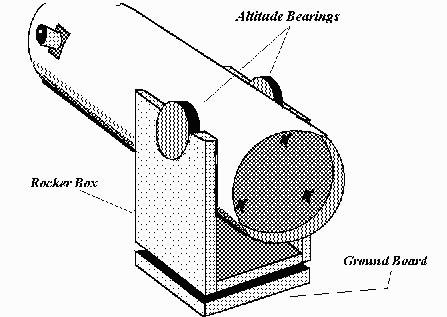
The base is referred to as the "ground board". The "rocker box" holds the telescope and is mounted to the ground board with a vertical axle and generally rests on teflon pads. The altitude bearing often is a circular piece of wood with smooth plastic or vinyl tile around its circumference; it, too, rides on teflon pads mounted to the rocker box. The altitude bearings are fastened to the telescope tube. The beauty of the Dobsonian is that the system can be disassembled simply by lifting the scope out of the rocker box. Setup and takedown time is minimal.
German Equatorial
The equatorial mounting has long been popular with amateur astronomers who do astrophotography work, and they're a convenience during prolonged observation of an object. The equatorial has a polar axis - one axle aimed at the celestial north pole. Movement about this axis is referred-to as movement in "right ascension". Because all objects in our sky appear to rotate around the celestial pole, it's easy to follow them simply by moving the telescope in one direction - right ascension. The declination axis provides the up-and-down movement that's used when re-aiming the scope at another object. The declination axle also carries a counterweight that offsets the weight of the telescope by moving it up or down the axle. The following page has an illustration of the German Equatorial mounting.
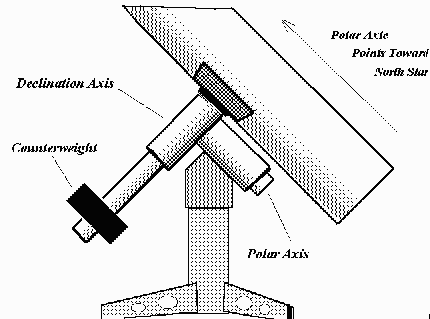
To use the equatorial mounting, it must first be polar-aligned. This means that the polar axle is aimed at the North Star (Polaris). In effect, this allows the telescope to rotate as the sky rotates, following objects as they move across the heavenly vault in an east-to-west direction. The polar axle is adjustable for your latitude. Thus, if the latitude of your observing site is 42o, the polar axle would be aimed 42o from the horizontal when facing north. If you sight along the polar axle, it should be pointing exactly at the North Star.
Clock drives are electric motor, gear, and clutch systems that drive the telescope in right ascension so that you can observe an object and never have to move the scope by hand. These drives are essential for astrophotos, which require long exposures and very precise tracking of the object photographed. (Sometimes drives are also added to the declination axis for fine adjustments when doing astrophotography.)
Fork Mount
The Fork mounting is another variation on the equatorial principle. Here the telescope tube is mounted between two arms - the fork. This is then mounted to a base which contains the motor drive. The base is affixed to the equatorial wedge, which allows the arms of the fork to be aimed toward the celestial pole. This type of mount is normally used with Schmidt-Cassegrain telescopes, which have short tubes. Longer tubes would not be able to swing through the arms of the fork, unless the arms were very long; this would make the mounting very unsteady. The newest types of fork mountings feature computerized drives which will automatically go to an object selected by the observer using the control pad or console. Moreover, some of these drives do not have to be polar-aligned, but can find their way around the sky from the altazimuth position. The observer simply sights in on a known object, then enters that object's coordinates into the computer. The computer does the rest by calculating the positions of other objects from the coordinates entered for the known object. Obviously, this type of mounting is quite expensive; this is the same type of system used at the large professional observatories.
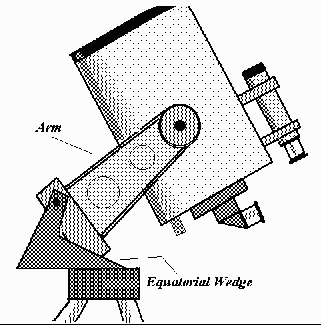
Although the fork mounting is ideally suited to the Schmidt-Cassegrain ("SCT") design, there is one disadvantage. Observing any object near the north celestial pole is very awkward because the eyepiece is then positioned inside the base of the fork. Also, the addition of some heavy accessories to the telescope can upset the balance of the system. Many observers employ sliding counterweights on the telescope to compensate for this. Suppliers of SCTs now offer the alternative of a German Equatorial mounting with their telescopes since this type of mounting with its large moveable counterweight lends itself to easy re-balancing. Nonetheless, for portability and ease of adding accessories, the fork mounting has a lot of advantages.
Which Mounting to Choose?
As we've seen, there are a variety of ways to design a mounting, and each one has certain advantages and disadvantages. When choosing a mounting, a great deal depends on the type and size of telescope it will be carrying. Not too many years ago, the German Equatorial and fork types were the most common. However, the simple, light-weight Dobsonian (altazimuth) mounting design has made large telescopes manageable by amateurs, resulting in a proliferation of big telescopes. Here's a situation where the mounting design has had a profound effect on the telescope itself.
Which mounting is best for you? That depends on how you intend to us it. The structural requirements of a German equatorial result in a very heavy mounting, especially as the size of the telescope increases. Those amateur astronomers who build large telescopes ("light buckets") almost always opt for a Dobsonian mounting. To do otherwise usually means that you'd need a permanently-mounted telescope in an observatory. As a matter of fact, most of the newest telescopes in professional observatories are being installed on altazimuth mountings due to their stability and lower cost. Professional instruments are motor-driven on both axes and computer-controlled so that the telescope is following the motion of celestial bodies on both axes simultaneously. A few amateur astronomers have done this and computer-controlled altazimuth configurations are available commercially. But the cost and technical knowhow required makes this prohibitive for most do-it-yourselfers. Therefore, the equatorial mounting is still quite popular in the amateur community...provided the telescope is not too large.
A word is in order about the motor-driven equatorial mountings supplied with commercially-made telescopes. Most are quite good, but a few are practically worthless. If you're taking an astrophoto, it'll be ruined if your telescope drive hesitates for a moment, if there's a momentary bind in the gear train, if the gear ratio is not exact, or if the motor is not consistently running at exactly the right speed. Drive correctors are accessories that are connected to the drive motor to electronically control the speed of the motor so as to more accurately follow the motion of celestial objects. Few astrophotographers would consider plying their craft without a drive corrector. But even a drive corrector won't help an inferior drive system. Several years ago, there was a relatively inexpensive telescope that came with a motor drive as standard. It was advertised as usable for astrophotography and backed this up with photos taken through the telescope. It turned out that while the photos were actually taken through that telescope, it had not been on the mounting that normally comes with it. Almost any motor-driven telescope is very handy for prolonged visual examination of objects, but many are very difficult to use for astrophotography. There's no general rule as to which is which, but price is a fairly reliable guide. You do get what you pay for. Here's another case where it's good to talk to more experienced amateur astronomers.





